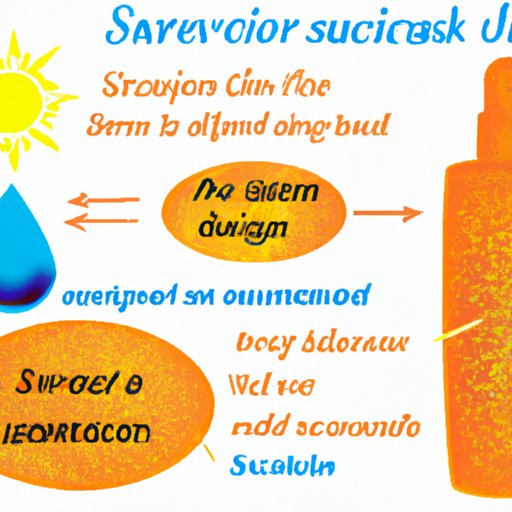
Introduction
As much as we all love that sun-kissed glow, we also know the dangers of overexposure to the sun. This is why sunscreen can be a great solution for those who want to indulge in some tanning while still protecting their skin from the harmful UV rays. However, there are many misconceptions about tanning with sunscreen that keep people from using it properly. In this article, we’ll debunk these myths, explore the science behind sunscreen and tanning, and provide practical tips for achieving a healthy, sun-kissed glow with sunscreen.
The Science Behind Sunscreen and Its Impact on Tanning
Before we dive into the myths and tips, let’s discuss the science behind sunscreen and tanning. When we expose ourselves to the sun, our skin absorbs UV radiation, which can cause various problems, including sunburn, premature aging, and skin cancer. The ingredients in sunscreens work to prevent these issues by either reflecting, scattering or absorbing the UV rays.
One such ingredient is titanium dioxide, which acts as a physical blocker of UV radiation, while avobenzone and oxybenzone absorb the UV radiation, making the rays less harmful to the skin. Zinc oxide, on the other hand, works as a physical blocker and covers a broader spectrum of UV rays. The effectiveness of sunscreens depends on their SPF (Sun Protection Factor) ratings that measure the level of protection against UVB radiation.
Using sunscreen can be a great way to protect the skin from harmful UV radiation and damage, but it also affects tanning. Sunscreens can reduce the amount of UV radiation that reaches the skin, limiting the amount of melanin produced by the body. Melanin is the pigment that gives our skin color and makes it tan. So as you can imagine, the more sunscreen you apply, the less UV radiation gets through, and the less tan you’ll get.
Debunking Myths about Sunscreen and Tanning
There are many misconceptions about sunscreen and tanning that prevent people from using sunscreen properly. Let’s debunk some of these common myths:
Myth: You can’t get tan with sunscreen.
Fact: While sunscreen can limit the level of melanin produced by the body, it doesn’t prevent tanning entirely. Using sunscreen with lower SPF allows some UV radiation to get through, which can cause the skin to tan while still providing protection against sunburns and skin damage.
Myth: Higher SPF is always better.
Fact: SPF only measures protection against UVB radiation, not UVA radiation. Also, higher SPF doesn’t mean that the product lasts longer and doesn’t substitute the need for reapplied frequently.
Myth: Sunscreen is only for fair-skinned people.
Fact: Everyone, regardless of skin type or color, needs to protect their skin from the sun’s harmful rays. People with darker skin are less susceptible to sunburn, but that doesn’t mean they are immune to the harmful effects of UV radiation.
How to Tan Safely with Sunscreen
Now that some of the myths are debunked let’s talk about how to tan safely with sunscreen. Here are some tips for achieving a natural glow:
1. Choose the right SPF level based on your skin type and the amount of sun exposure you’ll get.
2. Apply the sunscreen 15 to 30 minutes before going outside and reapply every two hours or immediately after swimming or sweating.
3. Be generous with your application. Use enough sunscreen to evenly coat all exposed skin areas.
4. Use additional protection like clothing, hats, and sunglasses to provide extra coverage on sensitive areas like the face and eyes.
The Pros and Cons of Tanning with Sunscreen
While sunscreen can reduce the intensity of tanning, it also comes with some benefits and drawbacks. Let’s take a closer look:
Pros:
– Prevents skin cancer and other sun-related health issues.
– Prevents premature aging of the skin.
– Provides a tanned look while still protecting the skin from harm.
Cons:
– Sunscreen can interfere with the tanning process by reducing the intensity of the tan.
– Sunscreen needs to be reapplied frequently, which can be inconvenient for many people.
– Using sunscreen isn’t always practical when swimming or doing water activities.
It’s essential to balance the pros and cons and weigh them based on your individual goals and preferences.
Protecting Your Skin from the Sun while Still Tanning
If using sunscreen isn’t an option, there are other ways to achieve a sun-kissed look safely. Products like self-tanners, spray tans, and other cosmetic options can provide a tan without the need for sun exposure. However, it’s essential to use these products safely and pick the right one that matches your skin tone and preferences.
The Long-term Effects of Tanning with and without Sunscreen
It’s essential to take measures for protecting our skin from sun damage because it can have severe consequences. Prolonged exposure to UV radiation can cause premature aging, sunburns, skin cancer, and other skin-related issues. According to the American Cancer Society, skin cancer is the most common form of cancer in the U.S., and overexposure to the sun is the leading cause of the disease. That’s why it’s crucial to be responsible and use sunscreen and other protective gear to reduce the risk of any of the mentioned health issues.
Conclusion
In conclusion, sunscreen plays a crucial role in protecting our skin from the sun’s harmful rays. It can reduce the intensity of tanning for some people, but it doesn’t prevent tanning entirely, making it possible to achieve a healthy, sun-kissed look. Even though the pros and cons of using sunscreen for tanning can be evaluated individually, protecting your skin from the sun should be your top priority. We hope this article helped debunk the myths about sunscreen and tanning and provided valuable insights into how to achieve a tan safely.




